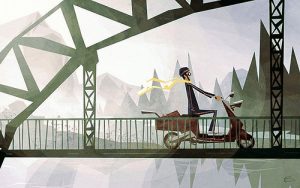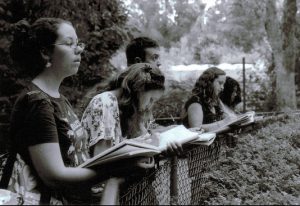Posts by Guest
Please welcome Lisa Barr to WU today!
Lisa is the author of the upcoming novel, THE UNBREAKABLES (Harper) releasing on June 4th. The book promises to be, “A delicious, sharp novel about a woman who jets off to France after her perfect marriage collapses, putting the broken pieces of herself back together while rediscovering her own joie de vivre—a lust for life, art, and steamy sex.” Publishers Weekly said of the book:
“This exquisitely wrought novel will appeal to readers who believe in the redemption of new beginnings.”
The story itself creates the jumping-off point for today’s blog post, because it wasn’t entirely made up. How did Lisa turn a real-life event into something fit for the fiction section of the bookstore? Read on! But first, a bit more about Lisa, from her bio:
Lisa’s debut, FUGITIVE COLORS–a suspenseful tale of stolen art, love, lust, deception and revenge on the “eve” of WWII–won the IPPY gold medal for “Best Literary Fiction 2014”, first prize at The Hollywood Film Festival (Opus Magnum Discovery Award), and was named on “HEEB” magazine’s “Top 10” best books list. According to Booklist, FUGITIVE COLORS is “masterfully conceived and crafted … a dazzling debut novel that has it all: passion and jealousy, intrigue and danger”.
Earning her master’s degree from the Medill School of Journalism, Northwestern University, Lisa has served as an editor for The Jerusalem Post, managing editor of Today’s Chicago Woman, managing editor of Moment magazine, and as an editor/reporter for the Chicago Sun-Times.
For more, visit lisabarr.com.
When Your Story Hits Too Close to Home
In 2002, this happened. My first husband, to whom I was married nine years, disappeared. He left me with two little girls, then five and three, with just 67 cents in my bank account. We have not seen nor heard from him since then. Oh, the story …. the twists and turns … along this nightmare, from despair to survival. Once our lives had finally quieted down, I knew I wanted to write about it. But this tale was not just my life, but my girls’ lives … could I write it? Should I? What would be the consequences? So I waited until my daughters were old enough to really understand. “Can I write our story?” I asked them both. “Yes,” they replied. So I spent the next year and a half writing a memoir. Once I finished it, my eldest who was entering high school at the time, said, “I changed my mind, Mommy. Please don’t write that book – it’s so embarrassing.” And so it goes … the memoir was shelved, but not the story, not the impact of what it did to me, did to us. The written story was dead, but the emotions were still very much alive and I used them within other works.
Flash forward to 2017… a close friend’s husband betrayed her in the worst possible way. “Can I write this story?” I asked her, intending to fictionalize it but keep the soul, the emotional intensity. “Yes,” she said generously, but then I saw the fear in her eyes. “I will show it to you,” I promised. “I will work […]
Read MoreWe’re thrilled to have multi-published author Stephanie Cowell back with us today for a guest post!
Stephanie is the author of Nicholas Cooke, The Physician of London, The Players: a novel of the young Shakespeare, Marrying Mozart and Claude & Camille: a novel of Monet. She is the recipient of an American Book Award. Her next novels (she hopes!) are Blanche and the Water Lilies (the story of the profound help and influence of Monet’s widowed daughter on his last great water lily paintings) and Robbie, a love story set in the English midlands 1900 between a young male artist and a married man. Her work has been translated into nine languages.
You can learn more about Stephanie’s work on her website.
The Ghost Worlds Within Me: A Novelist’s Journey
I first heard them as a young child, murmurs of another time and place. A low man’s voice, laughter, footsteps, a door closing. I was very young and quite alone a great deal. By the time I was eight, I had an imaginary friend. Where he came from I don’t know and only I could see him. He was lonely like me. I had to protect him.
My friend was my stability; I was an only child and the fractures in my parents’ marriage were running down the walls. I hid inside myself and in my room with the ghost worlds and ghost characters who assured me they loved me. They’d always been there for me. In a way I existed through them.
Where did the voices come from? Of course I read constantly and my ghost characters partially grew from my reading but also from deep inside me. By the time I was twelve, they became stories hand scribbled in a black-and-white school notebook. Museums, old houses, graveyards, empty streets inspired me. Then I banged out my worlds on my mother’s old typewriter. In my late teens I published several stories and then left writing to sing because writing was too lonely.
But the ghost world waited inside me and in my forties, it began to emerge again. I wrote four novels in seven years and at the end of that time, an editor from a good publishing house called me and said she wanted to buy my first novel with an option for the second. I lay in bed very faint the next day. I was about to open my inner world to strangers.
That book and the four that followed were great gifts …the things that happened to me, the people I met through them (including indirectly my husband and many dear friends), the events and the very welcome checks which paid for many extra things for my family. It was more than I could ever expect. And I found a lovely agent.
Then phrases began drifting into my world from agents and editors, ones I had not heard before: “Can you get your sales up?” “You write beautifully but that subject isn’t salable.” “Can it be about her brother rather than her love story?” “Nobody wants to hear about…” “You have to build a platform….” “We need more of a social media presence from you…”
I wanted to please the publishing world. I wanted them […]
Read MorePlease welcome back Alma Katsu to Writer Unboxed today! Alma is the award-winning author of THE HUNGER, a reimagining of the story of the Donner Party and one that Stephen King has called “Deeply, deeply disturbing.”
Additionally, THE HUNGER was on NPR’s list of 100 favorite horror stories, was named one of the best books of 2018 by Barnes & Noble and Amazon, and was just named a Bram Stoker Award finalist! It released in paperback two days ago, on March 5th.
Her debut novel, THE TAKER, was one of Booklist’s Top Ten Debut Novels of 2011.
Learn more about Alma on her website and by following her on Twitter.
Tips for Complex Historical Research
Is America afraid of doing research?
That’s the question I had to ask after touring for release of The Hunger, a reimagining of the story of the Donner Party with a horror twist. The question I was asked the most at events, hands down, was how did I manage the research for the book?
Why this horrified fascination for research? Were we all scarred writing research papers in high school?
I admit that the amount of research required for The Hunger was pretty daunting, but that’s because it wasn’t merely set in a historic period, it was about a specific and well-known historical event. It had to follow the actual route and timeline, and it also had to cover a huge cast of characters (there were roughly one hundred people in the wagon party, including children). I joke that there are, easily, ten thousand facts tucked throughout the book and that might be a conservative estimate.
Luckily, I was prepared: I’ve been a professional researcher for over 30 years. I’ve found it’s well-suited for historical fiction, maybe even more so than historians. The difference between historians and researchers is that researchers are trained to sift through information surrounding a subject quickly and efficiently in order to make logical sense of it and reduce it to its essential elements, while retaining integrity of all the facts.
Based on questions I’ve been asked, the two main problem areas for most writers seem to be: (1) How do you know when to stop gathering information (“help me, I can’t stop researching”) and (2) How do you organize and manage your notes? I firmly believe you don’t have to read everything that was ever written on your subject before you can start writing. However, you do need to have a sense of what you need to know and the discipline to trust your judgment.
A few tips to bear in mind:
Read MorePlease welcome Harper Glenn to Writer Unboxed today! Harper’s with us to share the story behind a work-in-progress, and an illuminating moment that changed everything.
Harper was born and raised in Georgia. She’s a lover of vintage brown paper, old cast iron flat irons, cracked mirrors, white sage, old cemeteries and writing dark #OWN narratives. She’s represented by Katie Shea Boutillier with The Donald Maass Literary Agency.
Learn more about Harper by visiting her website, and by following her on Twitter and Instagram.
Are You Tethered to the Wrong Story?
“Nothing ever goes away until it’s taught us everything we need to know.” It’s a cliché quote, quoted different ways, by many wise people. Nevertheless, it’s true—true in life, true while writing. But let’s jump out of the intro. And I’ll explain how holding onto the wrong WIP taught me to write the right one.
Autumn 2014, I was sitting outside a cafe somewhere in North Carolina, staring at a ginger-haired man rocking a larger than life beard. My imagination whirled. And later that night, my creative genius sat pensive behind my fingers and typed. We created a fictional character: a red-headed woman named Prue, who stalked and killed men with beards. Much like the fictional character Dexter, Prue had murder guidelines. Every man she killed must have red hair, a beard, and documented criminal cases. Prue was a librarian passionate about books, who secretly wrote a novel about her killings. Prue was my hero, a vigilante, protecting lives one cremation at a time.
“This is THE BOOK,” I’d thought. “It’s marketable. Prue’s gonna get me an agent.” She HAD to.
Because– Well, let’s go back.
Spring 2012, after completing my first manuscript, I queried over 65 agents, received over 40 rejections, garnered 10 partial requests, 3 full requests, and one R & R, but had no offers of representation. Attended my 1st writers conference: The Dallas-Fort Worth Writers Conference in Texas.
Between Fall 2012 – Spring 2014: I completed 1 NANOWRIMO, wrote 5 screenplays, and 2 manuscripts. I had 9 uncompleted manuscripts (word count ranging from 4k-25k). I queried over 50 agents, and had 12 partial requests but no one wanted the full; there were no offers of representation. I attended The New York Pitch Conference in NY. I got a few bites at the conference, but I chickened-out and didn’t send the manuscript.
Summer 2015, my wife and I separated. I stopped planning. Stopped writing. And after a year of depression, procrastination, no planning, no writing…I woke up. And wrote again.
Only things were different now. I was different; so was Prue. After my divorce, Prue became ruthless. She didn’t know why she was killing anymore—knocking-off men with black beards, brunette goatees, and yellow mustaches for no reason. And she didn’t care. Prue was a mess; I was a mess. We were two fast trains on opposite ends of the same track, and reality. We crashed. After the collision, my creative genius got into bed, hid its face, cried, fell asleep. I crawled into bed behind it, hid my face, cried, fell asleep.
Fall 2016, I woke up. I’d had a dream. In the dream, a young girl walked toward a forbidden bridge where a […]
Read MorePlease welcome today’s guest, Leigh Medeiros, to Writer Unboxed! Leigh is an award-winning artist, writer, coach, and story development editor. She supports artists of all kinds through her coaching and story development work as well as through her online program 48 Days of Creative Devotion. Her latest book, The 1-Minute Writer: 396 Microprompts to Spark Creativity and Recharge Your Writing, has been called “fun and thought provoking,” with exercises “to help you with writing’s most difficult step: starting” by the Editor and Reviewer for NPR Music, Stephen Thompson.
We’re thrilled to have her here today to talk about the power of prompts, and the true story that became her light-bulb moment.
Learn more about Leigh on her website, and by following her on Facebook and Instagram.
On Writing and Time Management: A Dispatch from the Kitchen Sink
It used to be that our kitchen sink was either full or empty depending on a complicated mathematical equation that involved calculating the estimated mass of plates, bowls, pots, pans, and silverware, then multiplying that number by the amount of currently available minutes. If the resulting sum was low enough, dishes would be washed and the sink subsequently returned to a Zen-like state of emptiness. If the sum was too high, dishes would languish, multiply, and steadily advance across counter tops like an ill-conceived army battalion.
One day, after struggling and failing to maneuver a glass around a mound of dishes to get a drink of water, I sat and pondered the wondrous dual nature of our kitchen sink. In a flash of brilliance, that can best be described as Well, DUH, I understood that the cause of dish overflow had nothing to do with cooking and everything to do with the perception of time and how I marked it.
I had, until that moment, looked at washing dishes as one task with a continuous beginning, middle, and end. I’d come upon the aftermath of the previous night’s dinner and think, this will take me half an hour, and I don’t have half an hour. What I realized in my moment of enlightenment was that I could – wait for it – do a few dishes at a time and slowly whittle the pile down over the course of multiple dishwashing sessions. Revelatory, right? To put it in other terms (ones that may salvage your impression of my intelligence), I came to understand in that moment that sustainability relies on manageability. I could not create a sustainable daily habit of washing dishes because I had not considered breaking that singular task down into smaller, more manageable chunks of time. That lack of manageability lead to overwhelm, which in turn lead to procrastination.
Unsurprisingly, my problem with doing the dishes was the very same problem I had with writing. The larger and more time-consuming a project was (i.e. books and screenplays) the less likely I was to sit down and write. The smaller the medium (i.e. emails, letters, Facebook updates, and blog posts), the easier to execute. In my heart of hearts, I desired to get those scripts and books written, and the longer I went without working […]
Read MorePlease welcome back today’s guest, DiAnn Mills!
DiAnn Mills is a bestselling author who believes her readers should expect an adventure. She is a storyteller and creates action-packed, suspense-filled novels to thrill readers. Her titles have appeared on the CBA and ECPA bestseller lists; won two Christy Awards; and been finalists for the RITA, Daphne Du Maurier, Inspirational Readers’ Choice, and Carol award contests.
DiAnn is a founding board member of the American Christian Fiction Writers, a member of Advanced Writers and Speakers Association, Mystery Writers of America, Sisters in Crime, and International Thriller Writers. She is co-director of The Blue Ridge Mountain Christian Writers Conference and The Mountainside Marketing Conference with social media specialist Edie Melson where she continues her passion of helping other writers be successful. She speaks to various groups and teaches writing workshops around the country.
Connect with DiAnn on her website.
Find Your Character’s Blind Spot
Every character has a blind spot, an area where he is most vulnerable. Within that emotional darkness, he lacks understanding, ignores the situation, or is unaware of potential harm. Through a series of planned deceptions, the opposition successfully deceives and manipulates the character. The consequences are often devastating.
The opposition can be nature, another person, society, a psychological or physical limitation, or spiritual indoctrination.
Discovering a blind spot paves the way to uncovering the character’s behavior, and the knowledge becomes a valuable part of the story. These shortcomings aren’t limited to antagonists. Our protagonists can be resistant to lies, charm, or an intoxicating lure. Emotion often masks logic, disguising truth and reason.
To find a stumbling block, begin by searching the character’s backstory.
Backstory
Backstory is the character’s life experience that affects the character’s goals, conflicts, and desires before chapter one. The information lays the foundation for the character’s personality. From the moment the character is born, her reactions and responses to her life experiences shape her mental, physical, emotional, and spiritual landscape. A child models behavior from parents and caregivers. False perceptions give the child a ragged view of how to handle problems. As the child grows, teachers, peers, and media shape values, attitudes, behaviors, and determine what motivates or doesn’t motivate a character.
From the backstory, we learn how flaws and weaknesses often create mental barriers. The character who is conscious of these can choose to overcome them. The character who disregards them will eventually face the consequences.
Protagonists and antagonists with blind spots are similar in the following ways:
The protagonist. Dealing with a blind spot is an opportunity for growth and change, either before or after the story begins. Sometimes realizing a blind spot is painful for a character, allowing the writer to create emotional tension that endears the reader to that character. These characters may become heroes and heroines.
Consider two scenarios:
Read More
Please welcome Katina Ferguson to Writer Unboxed today! Katina recently reached out to WU, at the recommendation of our own Grace Wynter, with a unique story. She’d come appreciate the work of (then) indie author Jonathan French after hearing him speak as a guest for another author’s book launch in Atlanta. Months later, she learned that one of his novels had been picked up by an imprint of Random House. Her inquiring mind wanted to know…everything! We’re thrilled she’s with us today to share some of what she discovered.
More about Katina from her bio:
Katina Ferguson is a bilingual French Canadian freelance writer and a literary translator in the making. She has contributed to WritersDigest.com, written articles for Vinings Lifestyle Magazine, and blogged for local small businesses.
Beyond the pen, Katina nurtures the growth and camaraderie of the writing community in Atlanta by organizing and facilitating critique sessions through her meetup group Atlanta Writes.
Learn more about her at: www.katinawrites.com
Any Means Necessary: A Hybrid Success Story
In the critique group I facilitate, the same pesky question comes up time and time again: Should I pitch my manuscript to agents and editors or go indie with it?
There is no right or wrong answer, but writers in the group have mixed opinions nonetheless—and by mixed, I mean polarized. Some writers refuse to consider indie publishing while others firmly stand in favor of self-publishing, no matter where it will take them. All cards on the table, I used to be on team #IndieForLife until I met Jonathan French, a local author willing to move forward by any means necessary. He is a rising star with his grimdark fantasy series, his third indie novel snagging him a two-book deal with Crown Publishing, a subsidiary of Random House. And you guessed it: Now he enjoys hybrid publishing success.
In a quest to understand French’s story and what led him to hybrid publishing, I reached out for an interview.
Here is what I learned:
1. It’s important to keep an open mind and know when to shift gears.
French completed his first novel, The Exiled Heir, in 2010. At the time, he fully intended to publish his book traditionally. His wife worked as a ghostwriter and beta-reader for a mid-list thriller novelist, and her position put him in contact with some good-to-know folks. He pitched his book to agents and editors at writers’ conferences and even captured the attention of a couple of agents, but none were able to land him a deal.
In 2012, he completed The Errantry of Bantam Flyn, the sequel to The Exiled Heir, and shopped that book around as well, but found no takers. That was when a highly-esteemed friend convinced French to move forward and self-publish his books—which he did. The significance of that decision is important to note because when writers have invested so much time into querying agents and solidifying their pitch, to no avail, choosing to go indie may not feel like progress; it can feel a lot more like giving up. For French, it was […]
Read MorePlease welcome Shannon Baker and Jess Lourey back to WU today!
Shannon Baker is author of the Kate Fox mystery series set in rural Nebraska cattle country, and the Nora Abbott mystery series, fast-paced mix of Hopi Indian mysticism, environmental issues, and murder. Now a resident of Tucson, Baker spent 20 years in the Nebraska Sandhills, where cattle outnumber people by more than 50:1. She is proud to have been chosen Rocky Mountain Fiction Writers’ 2014 and 2017 Writer of the Year.
A lover of the outdoors, she can be found backpacking in the Rockies, traipsing to the bottom of the Grand Canyon, skiing mountains and plains, kayaking lakes, hiking, cycling, and scuba diving whenever she gets the chance. Arizona sunsets notwithstanding, Baker is, and always will be, a Nebraska Husker. Go Big Red. Visit Shannon at www.Shannon-Baker.com. Bitter Rain is an August release.
Jess Lourey (rhymes with “dowry”) is an Amazon-bestselling Anthony, Lefty, and Agatha-nominated author known for her critically-acclaimed Mira James Mysteries, which have earned multiple starred reviews from Library Journal and Booklist, the latter calling her writing “a splendid mix of humor and suspense.” She is a tenured professor of creative writing and sociology, a recipient of The Loft’s Excellence in Teaching fellowship, a regular Psychology Today blogger, and a sought-after workshop leader and keynote speaker who delivered the 2016 “Rewrite Your Life” TEDx Talk. Mercy’s Chase, the second in the feminist thriller series Lee Child calls “highly recommended,” releases September 8. You can find out more at www.jessicalourey.com.
Write What You Fear: Why, How, and a Lifesaving Bonus Tip
May Day, my first published novel, came out in 2006. During my modest promotional tour, I was frequently asked where I got the idea for the book. My instincts told me to cover the real story with half-truths: I’ve always loved mysteries! Janet Evanovich wasn’t writing fast enough! I had poor TV reception and so wrote a book to entertain myself!
What I couldn’t say then, what it took me a decade to work up the nerve to admit, was that writing May Day was the process through which I worked through my husband’s suicide.
You’d think a murder mystery would be the last thing I’d want to dive into after dealing with brutal death, but as terrified as I was to write so close to home, I needed to confront what I most feared: the raw pain of loss, the guilt of unexpected death, and the possibility that I’d never find a reason to laugh again.
There was no better vehicle than a mystery.
Since that project, I’ve discovered that writing what you most fear is terrifying, but it’s the only way to go. Today, Shannon Baker and I would like to share the whys and hows of this transformative—for your writing and for you—process.
Jess says…WHY: Personal Healing
In 1996, Dr. Melanie A. Greenberg crafted a clever study where she measured the healing properties of writing about a real traumatic experience, an imaginary traumatic experience, and a real neutral experience (the control group). Her findings? People writing fictional versions of real-life fears […]
Read MorePlease welcome Patrice Williams Marks to Writer Unboxed today! Patrice recently reached out to Writer Unboxed to tell us about her free 7-day course on becoming a Sensitivity Reader, and an idea was born; this seemed like a post-worthy topic to us. We’re thrilled Patrice agreed to be our guest today, to answer a few worthy questions:
What is a Sensitivity Reader? Can you be one? Should you utilize one? Will a Sensitivity Reader censor?
A little about Patrice, from her bio:
Patrice Williams Marks is a Sensitivity Reader and Course Creator, founder of a non-profit charity that works to diversify the newsroom. She is the founder of several film festivals with diverse entries from filmmakers and writers. She also has a background in public relations, marketing, and journalism with an emphasis on research.
Learn more about Patrice on her website, and by following her on Facebook and Twitter. And learn more about her course online HERE and through the Sensitivity Read Twitter account. Oh, and Patrice is offering a free webinar on June 28th. Learn more about that HERE.
Enjoy!
What Is a Sensitivity Reader and Can I Become One?
In 2016, Scholastic pulled the children’s book, A Birthday Cake For George Washington, after outrage from what some considered “whitewashing” of the history of slavery.
The book showed “happy slaves” making a cake for George Washington. To those of us with ancestors who lived through that period of time–my father’s grandmother was a freed slave–it was not only hurtful but insulting.
We know that Scholastic (and the authors of the book) had no intention of insulting or whitewashing slavery, but nevertheless, they did just that. How? By writing about a culture they knew little about, and filling in the holes with assumptions though their own limited lenses.
As writers, we all “fill in the holes.” I have. But it has always been after extensive research.
What could they have done differently?
Hired an African-American Sensitivity Reader during the first draft phase of the book.
What exactly is a Sensitivity Reader, and how could s/he have helped?
A Sensitivity Reader is someone who specializes in a specific niche (African-American, Muslim, Physically Challenged, LGBTQ, Little People, etc.) and is a part of the specific marginalized community that the author is writing about. The Sensitivity Reader thoroughly reads over the material for bias, stereotypes, offensiveness, lack of understanding, etc. and creates a report for the client outlining their thoughts, why they feel something may be a problem, and offering possible solutions.
Will a Sensitivity Reader censor the work?
The client makes the final decision whether to make the changes suggested, make only a few changes, or keep the project as is. Therefore, a Sensitivity Reader cannot absolve another author or publishing company of any future negative impacts from their project.
Does a project need more than one Sensitivity Reader?
Possibly. If you are writing about more than one marginalized group, and you are not part of those groups, then you would do well to hire Sensitivity Readers who specialize in each group.
Read More
Flickr Creative Commons: Theophilos Papadopoulos
Kim here to welcome Dee Willson to Writer Unboxed today! Dee is the award-winning author of A Keeper’s Truth, GOT (Gift of Travel), and No Apology For Being(WIP). You can learn more about Dee on her website, Facebook and Twitter.
So, I find myself blocked by a mountain. Okay, maybe blocked is a strong word. I am facing a mountain. A big, unmovable mountain. This mountain is publishing in a very specific sense. It is the great divide between two major categories created by the publishing world only forty (or so) years ago, but holding strong, despite confusion and change. The divide between YA and ADULT.
Before I go any further, maybe I should be clear: genre and target market are two different things. First Books (FB, Birth-School), Middle Grade (MG, -12), Young Adult (YA, 13-18), Adult (ADULT, 18+)…these are demographics, audiences, ages used by sales, merchandising, and marketing people. Horror, romance, sci-fi, fantasy…these are genres. Stephen King straddles several genres, but mostly writes for an adult audience. Harry Potter, even the last of the series, targets the YA reader, kids under 18. Harry Potter falls under the fantasy genre. Some books blur genre lines, some appeal to more than one audience. I was excited when NEW ADULT hit the scene. But NA got twisted into a genre when it should have been a target market. Two very different things.
Gosh, Dee, get back to the mountain….
Recently, two contradictory things happened in the same moment.
I opened an email from my agent – feedback from the big boys of publishing regarding my latest manuscript. “Love it, but is the author willing to make the protagonist eighteen or under, make the book YA?” My first thoughts were wow, how the hell do I alter an entire manuscript to appeal to a different target market? Can I? Should I? Why? I don’t consider myself a YA author.
While reading this email, I was opening a package, a copy of The Chicago Manual of Style, Seventeenth Edition, ‘The Essential Guide for Writers, Editors, and Publishers’. For those unaware, this is an industry bible. The book mostly covers non-fiction and editorial tips, but what really struck me was that it’s in its seventeenth edition. As in: changed, updated…seventeen times since its original incarnation. I thought, here is this tome, this style manual, rewritten to include up-to-date details, keeping up with the times. It moves, turns like a spoke in some massive publishing wheel.
Would changing my manuscript to YA be a positive change, a nod to society, a give required by the 21st century? Would it tell my character’s story best? Would it sell more books? Would it make me, the author, flexible, a spoke? Or would it be surrender, giving in to a publishing push, intimidated by the mountain?
You might be wondering how I got to this thought process. So let’s take a step back.
I write characters in their early twenties, present day. First person, if it helps to know. It’s a difficult age to write, to voice. So much is happening at this age. And so much is not happening at this age. […]
Read MorePlease welcome author Abby Fabiaschi to WU today! Abby’s debut, I Liked My Life, releases in paperback this week. It has earned a starred Booklist review (“Warm and hopeful, this marvelous debut stands next to novels from Catherine McKenzie and Carolyn Parkhurst”), was named one of PopSugar’s best books (“A heartbreaking and ultimately heartwarming read about life, death, and family”), and became a Goodreads Choice nominee!
From her bio:
Abby Fabiaschi is a human rights advocate and co-founder of Empower Her Network, a nonprofit that paves a path for survivors of human trafficking with a will for independence. In 2012, Abby resigned from her executive post in high tech to pursue a career in writing. I Liked My Life is her first novel. She and her family divide their time between West Hartford, Connecticut, and Park City, Utah.
We’re thrilled to have her with us today to talk about her experience with a hard-to-define story.
Learn more at abbyfabiaschi.com and empowerhernetwork.org
Have a Tough-to-Describe Book? One Approach
In the hardcover copy for I Liked My Life, the second sentence reads:
“Maddy is the cornerstone of her family, a true matriarch … until she commits suicide, leaving her husband and teenage daughter heartbroken and reeling, wondering what happened.”
It would be right then— despite the fabulous author blurbs and catchy cover— that I, as a reader, would say, oh hell no. Here I am, tasked with balancing motherhood, marriage, and a career, convincing myself that the struggle is where the beauty lives while ignoring the suspicion I might be under-appreciated. Why would I pay money to hear about a woman who didn’t buy it and decided to teach everyone a lesson?
The sale would already be lost. But if I had read on— perhaps in bewilderment of why anyone would buy this depressing, indulgent novel— I would have gotten to this line a few paragraphs down:
Maddy, however, isn’t ready to leave her family forever. Watching from beyond, she tries to find her perfect replacement.
That’s when I’d have laughed out loud in the bookstore. Was ‘depressing paranormal disaster’ a new genre?
A Shaky Start
The book went to auction with four major imprints, but two editors bowed out, saying they loved the story but had no idea how to convince people to read it.
My novel was first listed on Publishers Marketplace as paranormal. (There is nothing wrong with paranormal, but someone expecting a paranormal story would not enjoy my book, and many people who would enjoy my book don’t search under paranormal.)
“St. Martin’s Press knows they bought a commercial fiction book, right?” I asked my agent.
“Yes,” she assured me. “They’re on it. There will be a reprint shortly.”
And there was … but the experience made me appreciate the validity of the feedback from the two editors who loved the story but opted out. I needed a plan to alert readers my book wasn’t what it seemed. Here’s what I came up with.
Owning It
On the book tour, I started talks with something like, “Before sharing the inspiration for the novel and its path to publication, it’s customary to offer a brief description of the story, which I dread because the book sounds depressing. So, let me first assure you: I Liked My Life is an uplifting tale of human resilience.”
Asking for Help
I’ve found the best way […]
Read MorePlease welcome former WU contributor Jane Friedman back to WU today! Jane has 20 years of experience in the publishing industry, with expertise in business strategy for authors and publishers. She’s the co-founder (with WU’s Porter Anderson) of The Hot Sheet, the essential industry newsletter for authors, and has previously worked for F+W Media (home to Writer’s Digest) and the Virginia Quarterly Review.
Jane’s newest book is The Business of Being a Writer (University of Chicago Press); Publishers Weekly wrote that it is “destined to become a staple reference book for writers and those interested in publishing careers.”
In addition to being a professor with The Great Courses, Jane has delivered keynotes and workshops on the digital era of authorship at worldwide industry events, including the Writer’s Digest annual conference, San Miguel Writers Conference, The Muse & The Marketplace, Frankfurt Book Fair, BookExpo America, LitFlow Berlin, and Digital Book World. Find out more at janefriedman.com.
A Smarter Author Platform for the Digital Era of Publishing
Author platform, in its simplest form, is an author’s ability to sell books. What that platform looks like, or how it works, varies from author to author: Some are big names who can attract attention with any book they release, others have figured out how to harness a local or regional fan base to spread word of mouth, and still others know how to use digital media for visibility.
But by far, digital media—and social media specifically—is the most prevalent and straightforward way that authors are now visible to readers and sell books. In some ways, this has changed publishers’ expectations—and what authors need to do regardless of how they’re published—but in other ways, the game has remained exactly the same. It’s just that now there are more game expansion packs, more players to navigate, and more rules that tend to change in the middle of game play.
Stop Focusing on Social Media Numbers and Look at Your Lead Gen Strategy Instead
When social media was still relatively new, there was a lot of focus and attention on the numbers. How many followers do you have? How many likes? How many shares?
While numbers are still a surface-level indicator of your platform strength, it’s too easy to boost social media activity in an artificial way, leading to numbers that are fairly meaningless. (Even with my own 224,000 followers on Twitter, which is 100% organically grown, a good portion consists of fake accounts that contribute nothing to my platform.) This is why there’s been more attention and focus lately on email newsletters—which indicate more highly engaged readers or followers, not casual or fake ones—and authors collaborating to cater to rather specific audiences or markets, such as Tall Poppy Writers.
A strategic author should evaluate their platform strength on three levels:
Social media can be disappointing when it comes to uncovering new readers if you aren’t spending ad dollars, but it does a great job at engaging people who are already aware of you and your work. Discounts and freebies—regardless of where they’re offered—tend to be better tools for finding new fans. I often hear from authors […]
Read MorePlease welcome author Laura Heffernan back to WU today! Book 3 in Laura’s America’s Next Reality Star series released just this month. Said bestselling author Kerry Lonsdale of the series:
“Smart, witty, and really freaking good, America’s Next Reality Star is a fun read that has you cheering from the first paragraph through the last page. Laura Heffernan spins an entertaining tale, expertly mixing the main character’s real life events with the reality show’s challenges. With enough drama to not only satisfy fans of reality TV shows, but readers who thrive on a good story with humor and romance, this book is a perfect read.”
Laura, who enjoys “watching total strangers get married, drag racing queens and cooking competitions; playing board games, travel, and baking” is currently working on her next series, Gamer Girl. Learn more about her on her website, on Facebook, or on Twitter where, she says, she spends far too much time tweeting about reality TV and Canadian chocolate. (Do we really believe “too much” and “chocolate” should appear in the same sentence together? I didn’t think so, either.)
Enjoy!
Quiz Your Fear
Writing can be daunting at times, whether it’s a novel, a short story, a blog post, or a poem. It’s easy to make excuses to avoid writing when you’re facing down a monster revision. Heck, I avoided looking at my latest rough draft for more than a month because I knew it would be terrible. But if you let fear control your writing, you’re dooming yourself to failure. You can’t finish a work you’re afraid to work on or afraid to start. Once you’ve identified the source of your fear, it’s often easier to determine what needs to be done to move on. So, ask yourself what you’re afraid of.
1. Do you feel unqualified to tackle the story line, themes, or characters? The best way to get started is to do some research. Read similar stories, talk to people like your characters, scour the internet for articles about your topic or themes, go to the public library and get some books. If you’re legitimately unprepared, the best solution is to prepare yourself–then dive in.
2. Are you afraid the book won’t be any good? Here’s a well-known secret in the writing community: first drafts are never good. I refer to my first drafts as a “vomit draft” or “garbage draft.” They’re barely English. It’s just me getting enough words on the page to figure out the story and fix it later.Last NaNovWriMo, I drafted the second book in the Gamer Girls series. I wrote every day. I wrote from my sister’s house, missing time with family I never see. I wrote when so exhausted from morning sickness, all I wanted to do was crawl under the covers and never get up–and it’s no coincidence that this first “draft” wound up with a seven page rant on how pregnancy sucks in the middle. It wasn’t written in the main character’s voice. At one point, I think I listed all the foods I wanted to eat but couldn’t. It was terrible. But that’s okay, because I got fifty thousand words on the page, and I’m in the process of fixing them. […]
Read MorePlease welcome literary agent with Trident Media Group Mark Gottlieb to WU today, speaking about something most writers need to understand: How to write (and even verbally deliver) an effective hook.
More about Mark from his bio:
Mark attended Emerson College and was President of its Publishing Club, establishing the Wilde Press. After graduating with a degree in writing, literature & publishing, he began his career with Penguin’s VP. Mark’s first position at Publishers Marketplace’s #1-ranked literary agency, Trident Media Group, was in foreign rights. Mark was EA to Trident’s Chairman and ran the Audio Department. Mark is currently working with his own client list, helping to manage and grow author careers with the unique resources available to Trident. He has ranked #1 among Literary Agents on publishersmarketplace.com in Overall Deals and other categories.
Learn more about Mark on the Trident Media website HERE.
How to Write an Effective Hook
I offer up this article on hook writing, also known as the elevator pitch, to lend the reader a feel for comfortable writing and public speaking in the fashion of selling a book idea to an agent, editor or publisher.
First I would like to share some real hook examples I’ve worked on with clients that have recently sold to publishers to lend a sense of what goes into a knock-out hook.
LILY & KOSMO, pitched in the tradition of A TALE DARK & GRIMM, FLORA & ULYSSES, and ALL THE WRONG QUESTIONS, in which to join Kosmo’s “Spacetronauts,” an all-boy crew of child space cadets, aboard their floating tree house in the stars, a girl from Brooklyn must prove that she can hold her own among the galaxy’s unruliest rascals…along the way, she and another will evade the clutches of merciless minions, find themselves marooned in The Murky Way nebula, and ultimately face the vilest villain of all, “His Meanness” The Mean-Man of Morgo.
THE REMAINDERS, pitched as DARK PLACES meets GIRL WITH THE DRAGON TATTOO, in which the daughter of a famed serial killer is compelled to meet the husband of one of her imprisoned mother’s victims, only to find he was murdered—she is made the prime suspect and is forced to flee, knowing she has very little time to find the truth before the police—or the real murderer—gets to her first.
Social media @XplodingUnicorn leader James Breakwell’s ONLY DEAD ON THE INSIDE: A PARENT’S GUIDE FOR SURVIVING ZOMBIES, styled in the tradition of Max Brooks’s THE ZOMBIE SURVIVAL GUIDE and THE WORST-CASE SCENARIO SURVIVAL HANDBOOK, providing practical advice on how to raise happy, healthy children in the midst of the zombie apocalypse, by joining the genres of parenting advice books and undead survival manuals in an unholy union that is both ill-advised and long overdue—the narrator, an inept father of four young daughters, uses twisted logic, graphs with dubious data, and web comics that look like they were drawn by a toddler to teach families how to survive undead hordes.
The nuts and bolts of what makes for a great hook
Let’s dissect what goes into a knock-out hook. The above examples (children’s book, adult fiction and nonfiction) demonstrate the construction of […]
Read More


















